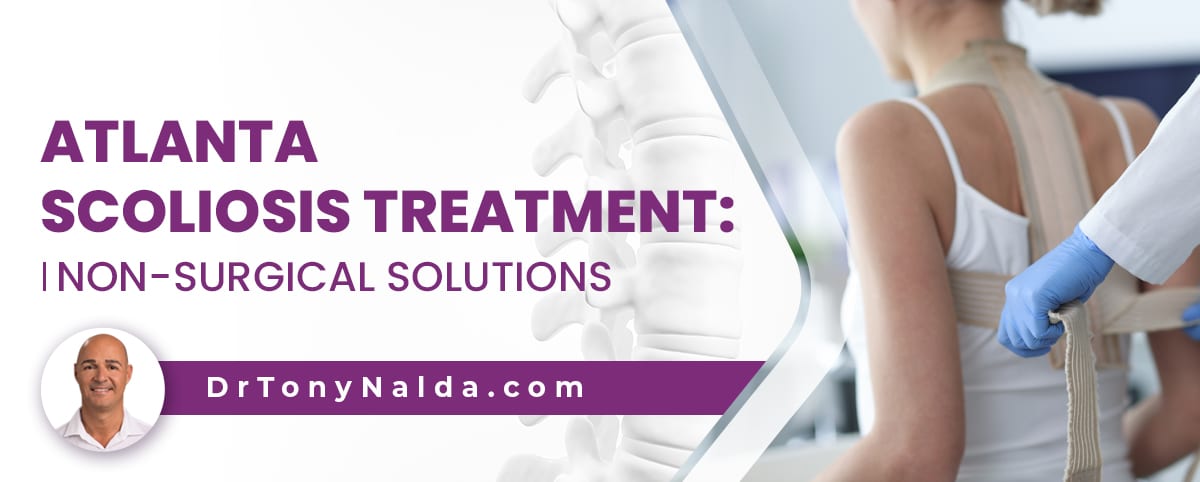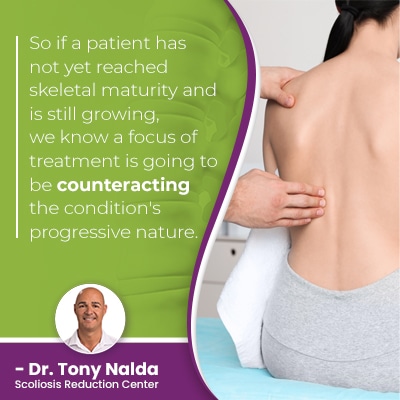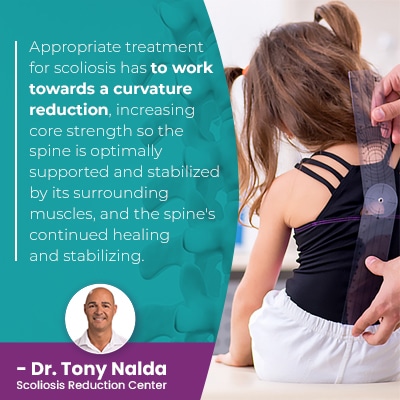Atlanta Scoliosis Treatment: Non-Surgical Solutions

Scoliosis treatment will shape how the spine functions in the future, so it's important for patients to be fully informed about all treatment options available. While traditional scoliosis treatment can funnel patients towards surgery; the reality is that many cases of scoliosis don't require spinal fusion.
There is more than one way to treat scoliosis. Nonsurgical treatment options have results that speak for themselves. For Atlanta, Georgia residents, access to one of the leading nonsurgical scoliosis treatment centers, the Scoliosis Reduction Center®, is within a one-hour flight, or a 7-hour drive to Orlando, Florida.
Scoliosis treatment is always necessary because as a progressive condition, scoliosis is incurable.
Table of Contents
Diagnosing Scoliosis
Being diagnosed with scoliosis means an unnatural spinal curve has developed; the curve will bend to the side, and the spine also rotates, making scoliosis a complex 3-dimensional condition.
As a progressive condition, the nature of scoliosis is to get worse over time, and this means the size of the unnatural spinal curve is increasing over time.
As the size of the curve increases, so do the condition's uneven forces, and their effects.
In children, postural changes will become more overt, as well as changes to movement, balance, and coordination, and adults will experience these changes also, along with increasing levels of pain.
Scoliosis is a highly-prevalent spinal condition with close to seven million people currently diagnosed in the United States, so awareness is important; it's also the leading spinal condition among school-aged children.
There are never treatment guarantees, but with early detection and intervention, there are fewer limits to what can be achieved with treatment; scoliosis can be highly treatable.
Part of diagnosing scoliosis involves further classifying conditions based on key patient/condition variables: patient age, condition type, severity, and curvature location.
Patient Age
 Patient age is a key factor because it determines a patient's likely rate of progression, and also determines whether scoliosis is compressive or not.
Patient age is a key factor because it determines a patient's likely rate of progression, and also determines whether scoliosis is compressive or not.
We don't always know what causes scoliosis to develop initially, but we know that growth is what makes it progress, which is why childhood scoliosis should always be taken seriously.
So if a patient has not yet reached skeletal maturity and is still growing, we know a focus of treatment is going to be counteracting the condition's progressive nature.
Once skeletal maturity is reached, scoliosis becomes a compressive condition, and this is when it commonly becomes painful.
Compression is uneven pressure, and it's compression of the spine and its surrounding muscles and nerves that causes the majority of condition-related pain.
So a focus of adult scoliosis is pain management, and pain in the back, pain that radiates into the extremities, and muscle pain are the main symptoms of adult scoliosis.
Progression and pain are two factors that shape treatment recommendations.
Condition Type
Condition type is determined by causation.
As mentioned, we don't always know what causes scoliosis to develop initially, and these cases are classified as idiopathic scoliosis: not clearly associated with a single-known cause.
The most prevalent type of scoliosis overall is adolescent idiopathic scoliosis, and the most common scoliosis symptom in children involve postural changes, and the most common scoliosis symptoms in adults include back pain, pain that radiates into the extremities due to nerve compression, and muscle pain.
Approximately 80 percent of diagnosed cases are classified as idiopathic, and the remaining 20 percent have known causes: neuromuscular scoliosis, degenerative scoliosis, and congenital scoliosis.
Determining condition type is an important step of treatment because treatment plans have to be shaped around important features like a condition's underlying cause.
In neuromuscular scoliosis, the scoliosis develops because of an underlying neuromuscular condition like spina bifida, muscular dystrophy, and cerebral palsy, so the larger neuromuscular condition has to be the focus of treatment.
Scoliosis cases with known causes are considered atypical and can have curves that bend to the left, towards the heart, when typical idiopathic curves bend to the right, away from the heart.
When I see a left-bending curve, this is a red flag that there is an underlying pathology causing the scoliosis to develop, and these can be among the most challenging cases to treat.
Degenerative scoliosis is caused by natural age-related spinal degeneration, and congenital scoliosis is caused by a malformed spine that develops in utero.
Degenerative scoliosis can involve degenerative disc disease and affects older adults, while congenital scoliosis affects babies who are born with the condition.
Condition Severity
Condition severity is an important characteristic as scoliosis can range widely from mild scoliosis to moderate scoliosis and severe and very severe scoliosis.
Condition severity is determined during X-ray by a measurement known as Cobb angle, and this involves drawing lines from the tops and bottoms of the curve's most-tilted vertebrae, and the resulting angle determines how unnaturally tilted the spine is.
The more severe a condition, the more likely it is that its effects will be noticeable, and a minimum Cobb angle of 10 degrees is necessary to be considered a true scoliosis.
Curvature Location
There are three main sections of the spine, and scoliosis can develop in any one section, or in more than one as a combined section.
The cervical spine refers to the neck, the thoracic spine includes the middle and upper back, and the lumbar spine is the lower back.
Each spinal section has its own unique functions; the cervical spine has to support the weight of the head and facilitate the neck's range of motion.
The thoracic spine is the only section attached to the rib cage so protects important organs and is the largest spinal section; it's most commonly affected by scoliosis.
The lumbar spine is vulnerable to a number of spinal conditions/issues as its vertebrae feel the effects of bending, lifting, and twisting motions.
In most spinal conditions, the area of the body located the closest to the affected spinal section is going to feel the majority of the condition's direct effects; for example, a common effect of lumbar scoliosis is sciatic nerve pain because the sciatic nerve starts in the lumbar spine.
Scoliosis Treatment
 Here at the Center, nonsurgical scoliosis treatment with proven results is provided by Dr. Tony Nalda, who's trained in multiple distinct treatment modalities so treatment plans can be fully customized.
Here at the Center, nonsurgical scoliosis treatment with proven results is provided by Dr. Tony Nalda, who's trained in multiple distinct treatment modalities so treatment plans can be fully customized.
Those traveling from Atlanta, Georgia can access nation-leading conservative scoliosis treatment within a 1-hour flight or a 7-hour drive.
Conservative treatment is integrative so combines multiple treatment disciplines so conditions can be impacted on every level, while addressing the condition's underlying structural nature.
Treatment disciplines are scoliosis-specific and include chiropractic care, physical therapy, corrective bracing, and rehabilitation.
Proactive nonsurgical treatment has the goal of preventing progression, increasing condition effects, and the need for invasive spinal fusion surgery.
Appropriate treatment for scoliosis has to work towards a curvature reduction, increasing core strength so the spine is optimally supported and stabilized by its surrounding muscles, and the spine's continued healing and stabilizing.
Scoliosis treatment doesn't always have to include spine surgery, particularly with early detection and intervention.
Surgical treatment is costly and invasive, and nonsurgical treatment offers a more natural treatment option, and treating patients with scoliosis is about managing an ongoing condition for the best quality of life.
Conclusion
Atlanta residents can access the Scoliosis Reduction Center's unique integrative treatment approach within a 7-hour drive or a 1-hour flight to Celebration, Orlando, Florida.
As a progressive spinal condition, the best time to start scoliosis treatment is always now.
An unnatural curvature of the spine needs to be addressed because it doesn't just affect the spine and its surrounding muscles and nerves, but also the entire body.
A physical examination and X-ray results are needed to reach a diagnosis of scoliosis, and when two or more vertebrae are unnaturally tilted and twisted, they can become more unnaturally tilted over time, particularly in severe cases.
The most common effect of childhood scoliosis involves postural changes such as uneven shoulders, uneven shoulder blades, and the development of a rib cage arch, and in adults, the main scoliosis symptom is pain; scoliosis becomes a compressive condition once skeletal maturity has been reached.
Spine related surgeries come with risks of infection, excessive blood loss, nerve damage, and more, and once a spine is fused, it's fused for life.
For those wanting to first try a less-invasive proactive treatment option, conservative chiropractic-centered treatment combines the power of chiropractic adjustments, physical therapy, an exercise program, corrective bracing, and rehabilitation specialists.
The most important thing to understand about scoliosis treatment is that as a progressive condition, the best time to start is always now; scoliosis only gets more complex to treat the more it progresses.
So if you, or a loved one, is concerned about scoliosis, the Center is here to help!
Dr. Tony Nalda
DOCTOR OF CHIROPRACTIC
After receiving an undergraduate degree in psychology and his Doctorate of Chiropractic from Life University, Dr. Nalda settled in Celebration, Florida and proceeded to build one of Central Florida’s most successful chiropractic clinics.
His experience with patients suffering from scoliosis, and the confusion and frustration they faced, led him to seek a specialty in scoliosis care. In 2006 he completed his Intensive Care Certification from CLEAR Institute, a leading scoliosis educational and certification center.
About Dr. Tony Nalda
 Ready to explore scoliosis treatment? Contact Us Now
Ready to explore scoliosis treatment? Contact Us Now





